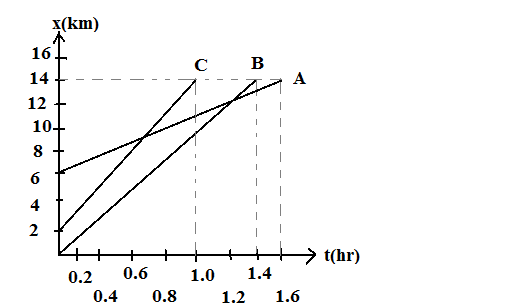
Which car has the highest speed and which car has the lowest speed?

Answer
220.8k+ views
Hint: Recall the various graphs in kinematics and what the properties of the graphs are. Also recall what area under the curve and slope of each graph gives. Answer accordingly to the data given in graphs.
Formula used:
Slope $ = \dfrac{{\Delta y}}{{\Delta x}} = \dfrac{{{y_2} - {y_1}}}{{{x_2} - {x_1}}}$
Complete step by step solution:
The given graph is a $x - t$ graph. We know that the slope of $x - t$ graph gives the speed. Thus the car whose slope is maximum has the maximum speed. Hence for these we need to find the slope in each case. We know,
Slope $ = \dfrac{{\Delta y}}{{\Delta x}} = \dfrac{{{y_2} - {y_1}}}{{{x_2} - {x_1}}}$
Thus,
Slope of A $ = \dfrac{{14 - 6}}{{1.6 - 0}} = \dfrac{8}{{1.6}} = 5km/hr$
Slope of B $ = \dfrac{{14 - 0}}{{1.4 - 0}} = \dfrac{{14}}{{1.4}} = 10km/hr$
Slope of C $ = \dfrac{{14 - 2}}{{1.0 - 0}} = \dfrac{{12}}{{1.0}} = 12km/hr$
After taking out the slopes, we infer that C has the maximum slope and A has the minimum slope.
Thus, C has the maximum speed and A has the minimum speed.
Additional Information:
There are three main motion graphs that tend to be studied in kinematics: displacement-time graphs, velocity-time graphs, and acceleration-time graphs. In all the three, time is present in the X-axis, while the others are present in Y-axis.
Following shows what does the slope and area of each graph corresponds to
Graphs are an easy way to study the nature of motion of a body. A curve in any of the graphs may not be a straight line; it can even be a curve.
Note: Do the calculations properly. Also do not make mistakes in interpreting the graph. Keep in mind the properties of all the graphs in kinematics within the scope of syllabus.
Formula used:
Slope $ = \dfrac{{\Delta y}}{{\Delta x}} = \dfrac{{{y_2} - {y_1}}}{{{x_2} - {x_1}}}$
Complete step by step solution:
The given graph is a $x - t$ graph. We know that the slope of $x - t$ graph gives the speed. Thus the car whose slope is maximum has the maximum speed. Hence for these we need to find the slope in each case. We know,
Slope $ = \dfrac{{\Delta y}}{{\Delta x}} = \dfrac{{{y_2} - {y_1}}}{{{x_2} - {x_1}}}$
Thus,
Slope of A $ = \dfrac{{14 - 6}}{{1.6 - 0}} = \dfrac{8}{{1.6}} = 5km/hr$
Slope of B $ = \dfrac{{14 - 0}}{{1.4 - 0}} = \dfrac{{14}}{{1.4}} = 10km/hr$
Slope of C $ = \dfrac{{14 - 2}}{{1.0 - 0}} = \dfrac{{12}}{{1.0}} = 12km/hr$
After taking out the slopes, we infer that C has the maximum slope and A has the minimum slope.
Thus, C has the maximum speed and A has the minimum speed.
Additional Information:
There are three main motion graphs that tend to be studied in kinematics: displacement-time graphs, velocity-time graphs, and acceleration-time graphs. In all the three, time is present in the X-axis, while the others are present in Y-axis.
Following shows what does the slope and area of each graph corresponds to
| Graph | Slope | Area |
| Displacement-time | Velocity | --- |
| Velocity-time | Acceleration | Displacement |
| Acceleration-time | --- | Velocity |
Graphs are an easy way to study the nature of motion of a body. A curve in any of the graphs may not be a straight line; it can even be a curve.
Note: Do the calculations properly. Also do not make mistakes in interpreting the graph. Keep in mind the properties of all the graphs in kinematics within the scope of syllabus.
Recently Updated Pages
Two discs which are rotating about their respective class 11 physics JEE_Main

A ladder rests against a frictionless vertical wall class 11 physics JEE_Main

Two simple pendulums of lengths 1 m and 16 m respectively class 11 physics JEE_Main

The slopes of isothermal and adiabatic curves are related class 11 physics JEE_Main

A trolly falling freely on an inclined plane as shown class 11 physics JEE_Main

The masses M1 and M2M2 M1 are released from rest Using class 11 physics JEE_Main

Trending doubts
JEE Main 2026: Application Form Open, Exam Dates, Syllabus, Eligibility & Question Papers

Derivation of Equation of Trajectory Explained for Students

Hybridisation in Chemistry – Concept, Types & Applications

Understanding the Angle of Deviation in a Prism

How to Convert a Galvanometer into an Ammeter or Voltmeter

Degree of Dissociation: Meaning, Formula, Calculation & Uses

Other Pages
Thermodynamics Class 11 Physics Chapter 11 CBSE Notes - 2025-26

JEE Advanced Marks vs Ranks 2025: Understanding Category-wise Qualifying Marks and Previous Year Cut-offs

Units And Measurements Class 11 Physics Chapter 1 CBSE Notes - 2025-26

NCERT Solutions For Class 11 Physics Chapter 8 Mechanical Properties Of Solids

Motion in a Straight Line Class 11 Physics Chapter 2 CBSE Notes - 2025-26

Laws of Motion Class 11 Physics Chapter 4 CBSE Notes - 2025-26




